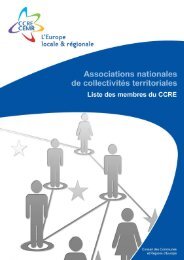Complementarities between urban and rural areas in promoting ...
Complementarities between urban and rural areas in promoting ...
Complementarities between urban and rural areas in promoting ...
You also want an ePaper? Increase the reach of your titles
YUMPU automatically turns print PDFs into web optimized ePapers that Google loves.
COMPLEMENTARITIES BETWEEN URBAN AND RURAL AREAS IN PROMOTING EMPLOYMENT AND SOCIAL INCLUSIONSem<strong>in</strong>ar on<strong>Complementarities</strong> <strong>between</strong> <strong>urban</strong> <strong>and</strong> <strong>rural</strong> <strong>areas</strong><strong>in</strong> promot<strong>in</strong>g employment <strong>and</strong> social <strong>in</strong>clusionWITH CONTRIBUTIONS FROM:●Cather<strong>in</strong>e de Borchgrave,Head of Unit,European Association for Information on Local Development (AEIDL)●Gerhard Bräunl<strong>in</strong>g,Adm<strong>in</strong>istrator, DG Employment <strong>and</strong> Social Affairs,European Commission●Patrick Gates,Community Regeneration Officer,Dubl<strong>in</strong> Inner City Partnership●Jussi Merikallio,Director of Social Services Department,City of Hels<strong>in</strong>ki (FIN)●Jorma Palola,Permanent Representative,Association of F<strong>in</strong>nish Local <strong>and</strong> Regional Authorities, Brussels●Dr. Matthias Schulze-Bö<strong>in</strong>g,Head of Department for Employment, Statistics <strong>and</strong> European Affairs,Municipality of Offenbach (D), <strong>and</strong> Chair of the CEMR Committeeon Employment & Social Affairs●Prof. Dr. Rolf-Ulrich Sprenger,Director of the Environmental, Regional <strong>and</strong> Transport Economics Department,at the IFO Institute for Economic Research <strong>in</strong> Munich●Paul Williams, County Rural Renewal Manager,Essex County Council (UK)Editor <strong>and</strong> researcher of report: Christoph Hermann, CEMR— 1 —
COMPLEMENTARITIES BETWEEN URBAN AND RURAL AREAS IN PROMOTING EMPLOYMENT AND SOCIAL INCLUSIONContentsINTRODUCTION . . . . . . . . . . . . . . . . . . . . . . . . . . . . . . . . . . . . . . . . . . . . . . . . . . . . . . . . . . . . . . . . . . . . . . . . . p. 4Jorma Palola, Permanent RepresentativeAssociation of F<strong>in</strong>nish Local <strong>and</strong> Regional Authorities (AFLRA)PART 1 . . . . . . . . . . . . . . . . . . . . . . . . . . . . . . . . . . . . . . . . . . . . . . . . . . . . . . . . . . . . . . . . . . . . . . . . . . . . . . . . . p. 6Initial thoughts on a balanced <strong>urban</strong> <strong>and</strong> <strong>rural</strong> development<strong>in</strong> promot<strong>in</strong>g employment <strong>and</strong> social <strong>in</strong>clusion1. Introduction . . . . . . . . . . . . . . . . . . . . . . . . . . . . . . . . . . . . . . . . . . . . . . . . . . . . . . . . . . . . . . . . . . . . . . . . p. 62. Def<strong>in</strong><strong>in</strong>g <strong>urban</strong>-<strong>rural</strong> relationships <strong>and</strong> develop<strong>in</strong>g <strong>in</strong>dicators for further research . . . . . . . . p. 73. How should balanced <strong>urban</strong> <strong>and</strong> <strong>rural</strong> policies forpromot<strong>in</strong>g employment <strong>and</strong> social <strong>in</strong>clusion be implemented? . . . . . . . . . . . . . . . . . . . . . . p. 8PART 2 . . . . . . . . . . . . . . . . . . . . . . . . . . . . . . . . . . . . . . . . . . . . . . . . . . . . . . . . . . . . . . . . . . . . . . . . . . . . . . . . . p. 11Exposés des OrateursSESSION 1Promot<strong>in</strong>g employment <strong>in</strong> <strong>urban</strong> <strong>and</strong> <strong>rural</strong> <strong>areas</strong>: some case studies . . . . . . . . . . . . . . . . . . . p. 11Measures to tackle long-term unemployment <strong>in</strong> <strong>urban</strong> <strong>and</strong> <strong>rural</strong> <strong>areas</strong>:examples of good practice <strong>in</strong> Germany . . . . . . . . . . . . . . . . . . . . . . . . . . . . . . . . . . . . . . . . . . . p. 11Matthias Schulze-Bö<strong>in</strong>g, Head of Department for Employment,Statistics <strong>and</strong> European Affairs, Municipality of Offenbach (D),<strong>and</strong> Chair of the CEMR Committtee on Employment & Social AffairsRural Employment <strong>in</strong> Essex: resolv<strong>in</strong>g the negative impactof unemployment <strong>in</strong> Essex . . . . . . . . . . . . . . . . . . . . . . . . . . . . . . . . . . . . . . . . . . . . . . . . . . . . . p. 13Paul Williams, County Rural Renewal Manager,Essex County Council (UK)SESSION 2Social <strong>in</strong>clusion <strong>in</strong> <strong>urban</strong> <strong>and</strong> <strong>rural</strong> <strong>areas</strong>: some case studies . . . . . . . . . . . . . . . . . . . . . . . . . . p. 16Introduction . . . . . . . . . . . . . . . . . . . . . . . . . . . . . . . . . . . . . . . . . . . . . . . . . . . . . . . . . . . . . . . . . . . . . . . . . p. 16Jorma Palola, Permanent Representative,Association of F<strong>in</strong>nish Local & Regional Authorities (AFLRA) (FIN)— 2 —
COMPLEMENTARITIES BETWEEN URBAN AND RURAL AREAS IN PROMOTING EMPLOYMENT AND SOCIAL INCLUSIONCombat<strong>in</strong>g social exclusion <strong>in</strong> the City of Hels<strong>in</strong>ki . . . . . . . . . . . . . . . . . . . . . . . . . . . . . . . . p. 17Jussi Merikallio, Director of Social Services Department,City of Hels<strong>in</strong>ki (FIN)Social <strong>in</strong>clusion <strong>in</strong> Northern Karelia: a substance free life - an ongo<strong>in</strong>g project . . . . . . . p. 18Jorma Palola, Permanent Representative, AFLRA (FIN)The role of local development <strong>in</strong> meet<strong>in</strong>g the challenges of unemployment<strong>and</strong> social <strong>in</strong>clusion: the EQUAL Initiative . . . . . . . . . . . . . . . . . . . . . . . . . . . . . . . . . . . . . . . p. 19Gerhard Bräunl<strong>in</strong>g, Adm<strong>in</strong>istrator, DG Employment<strong>and</strong> Social Affairs, European CommissionSESSION 3Partnerships, network<strong>in</strong>g <strong>and</strong> project management . . . . . . . . . . . . . . . . . . . . . . . . . . . . . . . . . . . p. 21IntroductionBuild<strong>in</strong>g <strong>and</strong> driv<strong>in</strong>g partnerships: how does it work? “The Essex Experience” . . . . . . . . . p. 21Paul Williams, County Rural Renewal Manager,Essex County County Council (UK)Network<strong>in</strong>g partnerships <strong>in</strong> <strong>rural</strong> <strong>areas</strong> (LEADER) . . . . . . . . . . . . . . . . . . . . . . . . . . . . . . . . . . p. 21Cather<strong>in</strong>e de Borchgrave, Head of Unit: Organisation of Events,European Association for Information on Local Development (AEIDL)Social <strong>and</strong> economic <strong>in</strong>clusion through area-based localdevelopment: the Dubl<strong>in</strong> Inner City Partnership . . . . . . . . . . . . . . . . . . . . . . . . . . . . . . . . . . . p. 22Patrick Gates, Community Regeneration Officer,Dubl<strong>in</strong> Inner City Partnership (IRL)Territorrial bottom-up <strong>in</strong>itiatives . . . . . . . . . . . . . . . . . . . . . . . . . . . . . . . . . . . . . . . . . . . . . . . . p. 23Rolf-Ulrich Sprenger, Director of the Environmental, Regional<strong>and</strong> Transport Economics Department, at the IFO Institute forEconomic Research <strong>in</strong> Munich (D)REFERENCES, LITERATURE FOR FURTHER READING . . . . . . . . . . . . . . . . . . . . . . . . . . . . . . . . . . p. 24— 3 —
COMPLEMENTARITIES BETWEEN URBAN AND RURAL AREAS IN PROMOTING EMPLOYMENT AND SOCIAL INCLUSIONIntroductionJorma Palola, Permanent Representative, Association of F<strong>in</strong>nish Local <strong>and</strong> Regional Authorities (AFLRA)This sem<strong>in</strong>ar, jo<strong>in</strong>tly organised by CEMR <strong>and</strong> theAssociation of F<strong>in</strong>nish Local <strong>and</strong> RegionalAuthorities, sought to br<strong>in</strong>g together two important<strong>areas</strong> of CEMR’s work: employment <strong>and</strong>social policy with cohesion policy. These <strong>areas</strong>addressed the common theme of complementarities<strong>between</strong> <strong>urban</strong> <strong>and</strong> <strong>rural</strong> <strong>areas</strong> <strong>in</strong> promot<strong>in</strong>gemployment <strong>and</strong> social <strong>in</strong>clusion. Representativesfrom regional authorities, academia<strong>and</strong> the European Commission participated <strong>in</strong>this event.Globalisation, the EU’s <strong>in</strong>ternal market policy<strong>and</strong> enlargement all strongly affect conditionsof social <strong>and</strong> economic welfare. Employment,social <strong>in</strong>clusion <strong>and</strong> regional development, thema<strong>in</strong> topics of this sem<strong>in</strong>ar, are essential for thewell be<strong>in</strong>g of all citizens. It is important toemphasise that these <strong>areas</strong> are closely <strong>in</strong>terconnected.The role of regional <strong>and</strong> local authoritiesis also significant <strong>in</strong> the practical application ofthese policy <strong>areas</strong>. Local democratically electedbodies have a specific role <strong>in</strong> translat<strong>in</strong>g the EU’s<strong>in</strong>itiatives <strong>in</strong>to local actions <strong>and</strong> <strong>in</strong> channell<strong>in</strong>glocal <strong>and</strong> regional needs <strong>in</strong>to national <strong>and</strong> EUdecision-mak<strong>in</strong>g. There is significant overlap<strong>between</strong> these different <strong>areas</strong> of policy.Problems of employment <strong>and</strong> social <strong>in</strong>clusioncan have specific <strong>rural</strong> <strong>and</strong> <strong>urban</strong> features.However, it is evident that these problems are<strong>in</strong>terdependent. For example, <strong>in</strong> F<strong>in</strong>l<strong>and</strong>, consequencesof substance abuse are often visible <strong>in</strong>both cities themselves <strong>and</strong> <strong>in</strong> their surround<strong>in</strong>g<strong>rural</strong> communities. This is one symptom of the<strong>in</strong>terrelations <strong>between</strong> <strong>urban</strong> <strong>and</strong> <strong>rural</strong> problemsthat needs to be tackled today. These problemsraise the question of how we could createmutually supportive policies <strong>and</strong> practical measuresof implementation to achieve a balanced<strong>urban</strong> <strong>and</strong> <strong>rural</strong> development.The fact that the European Union is revis<strong>in</strong>g itsemployment, social; cohesion <strong>and</strong> agriculturalpolicies, <strong>in</strong> view of the forthcom<strong>in</strong>g enlargement,gives a particular pert<strong>in</strong>ence <strong>and</strong> contextto these discussions today. In the com<strong>in</strong>gmonths, member states will also discuss <strong>and</strong>— 4 —
COMPLEMENTARITIES BETWEEN URBAN AND RURAL AREAS IN PROMOTING EMPLOYMENT AND SOCIAL INCLUSIONdecide on many national plans <strong>and</strong> objectivesaffect<strong>in</strong>g particular EU policies.CEMR’s Cohesion Work<strong>in</strong>g Group is work<strong>in</strong>g oncohesion policy <strong>and</strong> regional development, exam<strong>in</strong><strong>in</strong>gthe need for a balanced <strong>rural</strong> <strong>and</strong> <strong>urban</strong>development with<strong>in</strong> the European Union <strong>and</strong>assess<strong>in</strong>g how regions <strong>in</strong> the next structuralfunds post-2006 period need to develop theircomparative advantages.CEMR’s Committee on Employment <strong>and</strong> SocialPolicy is also work<strong>in</strong>g <strong>in</strong> this area. In October2001, a CEMR conference was held on the OpenCoord<strong>in</strong>ation Method. Open coord<strong>in</strong>ation is amutual feedback process of plann<strong>in</strong>g, exam<strong>in</strong>ation,comparison <strong>and</strong> adjustment of the policiesof EU member states. This is all done on the basisof common objectives.The Open Coord<strong>in</strong>ation Method leads to nationalaction plans (NAPs) which then result <strong>in</strong> newguidel<strong>in</strong>es <strong>in</strong> the <strong>areas</strong> of employment or social<strong>in</strong>clusion. CEMR regards the Open Coord<strong>in</strong>ationMethod as an <strong>in</strong>strument hav<strong>in</strong>g the capacity tol<strong>in</strong>k European strategy to <strong>in</strong>novation on theground. It is a means through which local <strong>and</strong>regional authorities are fac<strong>in</strong>g the challenge of<strong>in</strong>fluenc<strong>in</strong>g policy outcome. Employment <strong>and</strong>social <strong>in</strong>clusion are issues of great concern tolocal government. It should be added that localauthorities have developed new forms of governancewith<strong>in</strong> their territory to drive forward<strong>in</strong>novative actions <strong>in</strong> the <strong>areas</strong> of employment<strong>and</strong> social <strong>in</strong>clusion.This sem<strong>in</strong>ar focused on how a balanced development<strong>between</strong> <strong>urban</strong> <strong>and</strong> <strong>rural</strong> can be encouraged<strong>in</strong> the <strong>areas</strong> of employment <strong>and</strong> social<strong>in</strong>clusion. The first part of the sem<strong>in</strong>ar focusedon employment, the second part looked at social<strong>in</strong>clusion, <strong>and</strong> the third part addressed the coord<strong>in</strong>ationof local <strong>and</strong> regional governmentapproaches to promot<strong>in</strong>g social <strong>in</strong>clusion <strong>and</strong>employment <strong>in</strong> <strong>rural</strong> <strong>and</strong> <strong>urban</strong> <strong>areas</strong>. Emphasisis on a bottom-up approach. The sem<strong>in</strong>ar lookedat practical examples <strong>and</strong> discussions aimed atdraw<strong>in</strong>g out common themes.— 5 —
COMPLEMENTARITIES BETWEEN URBAN AND RURAL AREAS IN PROMOTING EMPLOYMENT AND SOCIAL INCLUSIONPART 1Initial thoughts on a balanced <strong>urban</strong><strong>and</strong> <strong>rural</strong> development <strong>in</strong> promot<strong>in</strong>gemployment <strong>and</strong> social <strong>in</strong>clusion1. IntroductionBalanced <strong>urban</strong> <strong>and</strong> <strong>rural</strong> development is animportant element to be considered <strong>in</strong> tackl<strong>in</strong>gemployment <strong>and</strong> social <strong>in</strong>clusion <strong>and</strong> should betaken <strong>in</strong>to greater account <strong>in</strong> the EU funded programmespost-2006. While the prevail<strong>in</strong>g socialcontexts differ, <strong>urban</strong> <strong>and</strong> <strong>rural</strong> development donot exist <strong>in</strong> isolation <strong>and</strong> the practical measurestaken to address these problems are often thesame. Cooperation <strong>and</strong> coord<strong>in</strong>ation <strong>between</strong>local government <strong>in</strong> cities <strong>and</strong> <strong>rural</strong> <strong>areas</strong> cancontribute to mutually beneficial solutions <strong>and</strong>can improve the liv<strong>in</strong>g conditions of the population<strong>in</strong> both <strong>areas</strong>.Interdependencies <strong>between</strong> <strong>rural</strong> <strong>and</strong> <strong>urban</strong><strong>areas</strong> vary from region to region <strong>and</strong> are dependanton the spatial <strong>and</strong> structural context oftheir respective <strong>areas</strong>.1.2. TOWARDS A COMPLEMENTARY APPROACHCooperation <strong>between</strong> <strong>urban</strong> <strong>and</strong> <strong>rural</strong> <strong>areas</strong>should create comprehensive social <strong>and</strong> economicbenefits. These <strong>areas</strong> can provide a valuablecomplement to each other. Urban <strong>and</strong> <strong>rural</strong> <strong>areas</strong>can benefit <strong>and</strong> learn from each other <strong>in</strong> termsof the tools <strong>and</strong> processes used <strong>in</strong> order to tacklesocial exclusion <strong>and</strong> unemployment.1.1. INTERDEPENDENCIES BETWEEN URBANAND RURAL AREASTraditionally, <strong>urban</strong> <strong>and</strong> <strong>rural</strong> <strong>areas</strong> have oftenbeen seen as exclusive <strong>areas</strong>. EU structural fundsprojects have, to date, not laid a particularemphasis on <strong>in</strong>tegrat<strong>in</strong>g the different processesof <strong>rural</strong> <strong>and</strong> <strong>urban</strong> employment <strong>and</strong> social <strong>in</strong>clusion.Nevertheless, <strong>in</strong>terdependencies <strong>between</strong><strong>rural</strong> <strong>and</strong> <strong>urban</strong> <strong>areas</strong> have always existed <strong>and</strong>these have become more complex over recentdecades. The <strong>in</strong>creas<strong>in</strong>gly complex relationship<strong>between</strong> <strong>urban</strong> <strong>and</strong> <strong>rural</strong> <strong>areas</strong> is caused bygreater mobility <strong>and</strong> accessibility <strong>between</strong> town<strong>and</strong> country.Cooperation <strong>and</strong> complementary learn<strong>in</strong>g processescan be promoted through networks of<strong>urban</strong> <strong>and</strong> <strong>rural</strong> <strong>areas</strong>. These networks can be ofa regional, <strong>in</strong>terregional or trans-national character,<strong>and</strong> can help to create a more even economic<strong>and</strong> social development. However, meansof cooperation <strong>between</strong> <strong>urban</strong> <strong>and</strong> <strong>rural</strong> <strong>areas</strong>might differ accord<strong>in</strong>g to the vary<strong>in</strong>g structural<strong>and</strong> spatial relationships exist<strong>in</strong>g <strong>between</strong> thesetwo <strong>areas</strong>.— 6 —Interdependencies <strong>between</strong> <strong>urban</strong> <strong>and</strong> <strong>rural</strong><strong>areas</strong> can be described <strong>in</strong> terms of populationflows such as movement of people <strong>in</strong> search foremployment, education <strong>and</strong> tra<strong>in</strong><strong>in</strong>g, or recreation.It is also evident that these <strong>in</strong>terdependenciescan be described <strong>in</strong> terms of structures.
COMPLEMENTARITIES BETWEEN URBAN AND RURAL AREAS IN PROMOTING EMPLOYMENT AND SOCIAL INCLUSION2. Def<strong>in</strong><strong>in</strong>g <strong>urban</strong>-<strong>rural</strong> relationships <strong>and</strong> develop<strong>in</strong>g<strong>in</strong>dicators for further research2.1. THE DIFFICULTY OF ASSESSINGTHE URBAN-RURAL PHENOMENON2.2. INDICATORS FOR ANALYSINGURBAN-RURAL RELATIONSHIPSPrevious academic def<strong>in</strong>itions were consideredsufficient to provide a consistent picture of thedist<strong>in</strong>ctions <strong>between</strong> <strong>urban</strong> <strong>and</strong> <strong>rural</strong> <strong>areas</strong>.Nevertheless, today these differences <strong>between</strong><strong>urban</strong> <strong>and</strong> <strong>rural</strong> <strong>areas</strong> are less clear-cut <strong>and</strong> thereare limits to the theories that have beenapplied to date. It would seem that no s<strong>in</strong>gleapproach provides an exact def<strong>in</strong>ition <strong>and</strong> thechallenge of def<strong>in</strong><strong>in</strong>g what is ‘<strong>urban</strong>’ <strong>and</strong> what is‘<strong>rural</strong>’ rema<strong>in</strong>s.A new approach to classify<strong>in</strong>g <strong>urban</strong> <strong>and</strong> <strong>rural</strong><strong>areas</strong> was recently presented by the EuropeanSpatial Observation Network <strong>in</strong> their first <strong>in</strong>terimreport (1) <strong>in</strong> which they suggest that a dist<strong>in</strong>ctionis made <strong>between</strong>:■ regions dom<strong>in</strong>ated by a large city;■ polycentric regions with high <strong>urban</strong> <strong>and</strong> <strong>rural</strong>density;■ polycentric regions with high <strong>urban</strong> density;■ networks of small towns;■ remote <strong>rural</strong> <strong>areas</strong>.In order to be able to analyse <strong>urban</strong>-<strong>rural</strong> relationships,it is necessary to develop territorial<strong>in</strong>dicators <strong>and</strong> typologies capable of identify<strong>in</strong>g<strong>and</strong> measur<strong>in</strong>g development trends as well asmonitor<strong>in</strong>g political developments towards amore balanced <strong>and</strong> polycentric EU policy.To date, the ESPON network has developed acomprehensive list of <strong>in</strong>dicators which serve asa pool for the selection of <strong>in</strong>dicators, accord<strong>in</strong>gto different requirements of the study. These<strong>in</strong>dicators have been assigned to three categories.■ Basic <strong>in</strong>dicators for the first tests of the del<strong>in</strong>eationof <strong>urban</strong> <strong>and</strong> <strong>rural</strong> regions.■ Indicators for the quantitative analysis of<strong>urban</strong> <strong>and</strong> <strong>rural</strong> developments <strong>and</strong> relationships<strong>between</strong> them.■ Indicators for qualitative analysis <strong>in</strong> case studies.On the one h<strong>and</strong>, this classification illustratesthe complexity of the different patterns of relationship<strong>between</strong> <strong>urban</strong> <strong>and</strong> <strong>rural</strong> <strong>areas</strong>. It has,on the other h<strong>and</strong>, been po<strong>in</strong>ted out that this isbased on physical agglomeration def<strong>in</strong>ition (ie.population density <strong>and</strong>/or l<strong>and</strong> use) <strong>and</strong> not on amore functional def<strong>in</strong>ition that can potentially<strong>in</strong>clude more complex relationships with<strong>in</strong>territories.Further analysis would be necessary <strong>in</strong> order toref<strong>in</strong>e the quality of <strong>in</strong>dicators that could be used.— 7 —1. The full first <strong>in</strong>terim report of the European Spatial ObservationNetwork can be found at www.espon.lu
COMPLEMENTARITIES BETWEEN URBAN AND RURAL AREAS IN PROMOTING EMPLOYMENT AND SOCIAL INCLUSION3. How should balanced <strong>urban</strong> <strong>and</strong> <strong>rural</strong>policies for promot<strong>in</strong>g employment <strong>and</strong>social <strong>in</strong>clusion be implemented?— 8 —3.1. POLICIES FOR COMBATING SOCIALEXCLUSION AND PROMOTINGEMPLOYMENT IN URBAN AND RURALAREAS SHOULD BE MUTUALLY SUPPORTIVE●●●Rural <strong>and</strong> <strong>urban</strong> development takes place <strong>in</strong>close <strong>in</strong>teraction <strong>and</strong> is mutually beneficial. Abalanced distribution of opportunities foremployment is crucial for susta<strong>in</strong>able development<strong>in</strong> <strong>urban</strong> <strong>and</strong> <strong>rural</strong> <strong>areas</strong>. Future structuralfunds programmes should encourage susta<strong>in</strong>able<strong>and</strong> <strong>in</strong>tegrated regional development <strong>and</strong><strong>urban</strong> consolidation, the growth of small- ormedium-sized cities <strong>and</strong> susta<strong>in</strong>able <strong>rural</strong> developmentby creat<strong>in</strong>g labour-<strong>in</strong>tensive projects,tra<strong>in</strong><strong>in</strong>g for non-farm<strong>in</strong>g jobs <strong>and</strong> should ensureeffective transport, <strong>and</strong> communications <strong>and</strong>other essential <strong>in</strong>frastructures. Decentralisationof adm<strong>in</strong>istration, expenditure, taxation <strong>and</strong>services should be considered to facilitate localdevelopment.On the one h<strong>and</strong>, long-term unemployment <strong>and</strong>experience of social exclusion <strong>in</strong> <strong>urban</strong> <strong>areas</strong> isdifferent from that of <strong>rural</strong> <strong>areas</strong>. However thepractical measures taken to resolv<strong>in</strong>g these problemsare largely the same, although the opportunitiesfor employment may differ greatly. Thetools <strong>and</strong> measures used <strong>in</strong> previous <strong>and</strong>ongo<strong>in</strong>g local employment URBAN <strong>and</strong> LEADERprojects have shown great similarities: they take<strong>in</strong>to account local conditions, resources, networks,civic organisations <strong>and</strong> the existence oflocal community facilities. Urban <strong>and</strong> <strong>rural</strong>municipalities could take account of eachother’s experiences <strong>in</strong> prevent<strong>in</strong>g long-termunemployment <strong>and</strong> social exclusion.Moreover, the opportunities offered by newtechnologies for ensur<strong>in</strong>g cont<strong>in</strong>ued employment<strong>in</strong> <strong>rural</strong> <strong>and</strong> <strong>urban</strong> municipalities should beexam<strong>in</strong>ed. Telework <strong>and</strong> other new forms ofemployment could help to create new jobs <strong>and</strong>provide opportunities for new ways of work<strong>in</strong>g.Telework also provides opportunities for exist<strong>in</strong>gemployees.3.2. THE OPEN METHOD OF COORDINATION AS ATOOL FOR A BALANCED URBAN AND RURALDEVELOPMENT●●●As already stated, a “one-size fit all” approachwould not solve the problems of social exclusion<strong>and</strong> employment <strong>in</strong> cities <strong>and</strong> the countryside, asthe situation varies from area to area. Culturalfactors <strong>and</strong> differences <strong>in</strong> the physical environmentfurther complicate comparisons. Nevertheless,it is very important to discuss issuesrelated to <strong>rural</strong> <strong>and</strong> <strong>urban</strong> development side byside, <strong>in</strong> order to be able to assess how EU actions<strong>in</strong> these <strong>areas</strong> complement each other. Socialexclusion as well as unemployment requirescareful analysis <strong>in</strong> order to be able to assess theoften complex problems these phenomena entail.The Open Method of Coord<strong>in</strong>ation, as <strong>in</strong>itiatedby the Luxembourg <strong>and</strong> Lisbon Summits, is thereforean important tool for combat<strong>in</strong>g socialexclusion <strong>and</strong> long-term unemployment <strong>in</strong> <strong>urban</strong><strong>and</strong> <strong>rural</strong> <strong>areas</strong>. Its methods <strong>and</strong> approachesshould be further developed.In addition, the national associations of local<strong>and</strong> regional authorities should be <strong>in</strong>volved <strong>in</strong>the sett<strong>in</strong>g up of the national action plans, aslocal <strong>and</strong> regional authorities are often key players<strong>in</strong> implement<strong>in</strong>g employment programmes <strong>and</strong>have important knowledge on these matters.Likewise, CEMR, as their European representative,should be consulted <strong>in</strong> the def<strong>in</strong>ition <strong>and</strong>development of the European Employment Strategy.
COMPLEMENTARITIES BETWEEN URBAN AND RURAL AREAS IN PROMOTING EMPLOYMENT AND SOCIAL INCLUSION●●Here, benchmark<strong>in</strong>g is a useful <strong>and</strong> importanttool for promot<strong>in</strong>g employment <strong>and</strong> social <strong>in</strong>clusionprogrammes at the local <strong>and</strong> regional levels.The availability of comparative data or <strong>in</strong>formationon the exchange of experience on particularfeatures of social problems <strong>in</strong> <strong>urban</strong> <strong>and</strong> <strong>rural</strong>communities, <strong>and</strong> on approaches towards solv<strong>in</strong>gthese, can contribute to the development ofmutually complementary approaches <strong>in</strong> differentpolicy sectors. It is important to furtherdevelop the tools applied here to make benchmark<strong>in</strong>gmore adaptable to the specific needs ofthe different <strong>areas</strong> <strong>and</strong> to simultaneously allowthe coord<strong>in</strong>ation of a balanced <strong>rural</strong> <strong>and</strong> <strong>urban</strong>development.The Urban Audit has produced a great deal of<strong>in</strong>formation on the problems <strong>and</strong> developmentissues of cities. Although it is important tomonitor the development of large cities, theUrban Audit should be extended to <strong>in</strong>cludemedium-sized cities <strong>and</strong> the <strong>in</strong>formation should,<strong>in</strong> order to improve the <strong>urban</strong> - <strong>rural</strong> balance, bestudied from the perspective of the region/<strong>rural</strong><strong>areas</strong> adjacent to cities. Small <strong>and</strong> medium sizedtowns are important centres <strong>in</strong> predom<strong>in</strong>antly<strong>rural</strong> <strong>areas</strong>. They should receive more support <strong>in</strong>order to ma<strong>in</strong>ta<strong>in</strong> the viability of the surround<strong>in</strong>gcountryside.3.3. GOVERNANCE, NETWORKING ANDPARTNERSHIP AS CRUCIAL ELEMENTSFOR BALANCED RURAL AND URBANDEVELOPMENT●●Keep<strong>in</strong>g <strong>in</strong> m<strong>in</strong>d the pr<strong>in</strong>ciple of subsidiarity,there should be a greater recognition that local<strong>and</strong> regional authorities are at the forefront oftackl<strong>in</strong>g social exclusion <strong>and</strong> unemployment <strong>and</strong>that they have an important role <strong>in</strong> f<strong>in</strong>d<strong>in</strong>g practical<strong>and</strong> immediate solutions. This has alreadybeen demonstrated by URBAN <strong>and</strong> LEADER programmeswhere municipalities are often thema<strong>in</strong> actors <strong>in</strong> implementation processes.Cohesion policy should promote <strong>and</strong> strengthenthe roles of the local <strong>and</strong> regional authorities <strong>in</strong>●order to further develop its’ goal of social <strong>in</strong>tegration<strong>and</strong> to dissem<strong>in</strong>ate best practice. Spatialregional plann<strong>in</strong>g as well as the creation <strong>and</strong>test<strong>in</strong>g of the new <strong>in</strong>stitutional forms <strong>and</strong> policy<strong>in</strong>struments that <strong>in</strong>tegrate <strong>urban</strong> <strong>and</strong> <strong>rural</strong>concerns can lead to a better economic developmentof both <strong>areas</strong>. Only a comprehensive <strong>and</strong><strong>in</strong>tegrated network strategy can tackle <strong>urban</strong><strong>and</strong> <strong>rural</strong> issues. This should also be the natureof a European <strong>urban</strong> <strong>and</strong> <strong>rural</strong> policy, as opposedto a sector-based approach.Partnership <strong>and</strong> network<strong>in</strong>g <strong>between</strong> <strong>rural</strong> <strong>and</strong><strong>urban</strong> <strong>areas</strong> should not only be promoted atregional level but also at the <strong>in</strong>terregional <strong>and</strong>transnational levels. Good examples for this typeof cooperation have already been provided byINTERREG programmes. Networks <strong>between</strong> <strong>urban</strong><strong>and</strong> <strong>rural</strong> <strong>areas</strong>, especially on an EU-wide level,could facilitate mutual learn<strong>in</strong>g.3.4. THE CAP SHOULD EMPHASIZETHE CREATION OF A MORE DIVERSERURAL DEVELOPMENT●●There has been a strong emphasis on shift<strong>in</strong>g thefocus towards <strong>rural</strong> development <strong>in</strong> the preparationsfor the reform of the common agriculturalpolicy (CAP). The CAP, as it is currently constituted,is unsusta<strong>in</strong>able both with<strong>in</strong> the EuropeanUnion <strong>and</strong> on a global level. It is therefore necessaryto <strong>in</strong>clude development measures outsideagriculture <strong>in</strong>to these programmes <strong>and</strong> to supportthe experience <strong>rural</strong> <strong>areas</strong> have <strong>in</strong> the developmentof non-agricultural economic activities<strong>and</strong> other <strong>rural</strong> developments.The opportunities for establish<strong>in</strong>g last<strong>in</strong>g <strong>and</strong>viable small <strong>and</strong> medium-sized bus<strong>in</strong>esses <strong>in</strong><strong>rural</strong> <strong>areas</strong> should be supported. Such bus<strong>in</strong>essescontribute to a balanced development of <strong>rural</strong><strong>areas</strong> <strong>and</strong> their pr<strong>in</strong>cipal towns. Lessons shouldbe drawn from earlier experiences with Article33 so that development measures outside ofagriculture <strong>and</strong> forestry would be <strong>in</strong>cluded <strong>in</strong>this form of aid to a greater extent. This wouldmean that small bus<strong>in</strong>esses <strong>in</strong> <strong>rural</strong> <strong>areas</strong> would— 9 —
COMPLEMENTARITIES BETWEEN URBAN AND RURAL AREAS IN PROMOTING EMPLOYMENT AND SOCIAL INCLUSION●receive support even though they are not directlyl<strong>in</strong>ked to farm<strong>in</strong>g. Extend<strong>in</strong>g the LEADER+<strong>in</strong>itiative <strong>and</strong> allocat<strong>in</strong>g more resources to itwould also serve this purpose.A simplification of the legislation on <strong>rural</strong> development,its’ implementation <strong>and</strong> paymentrequirements is a central objective for strengthen<strong>in</strong>gthe second pillar. This would mean an<strong>in</strong>creased delegation of decision mak<strong>in</strong>g to themember states <strong>and</strong> regions to enable them tobetter respond to local needs.3.5. THE IMPORTANCE OF IMPROVINGTRANSPORT AND ACCESSIBILITY●The development of Trans-European Networks(TENs) of transportation provides one perspectiveon how <strong>rural</strong> <strong>areas</strong> <strong>and</strong> large <strong>urban</strong> growth●centres can both be given attention. Trans-EuropeanNetworks also give more peripheral regionsof the EU the possibility to have fast <strong>and</strong> efficienttransport access, thus improv<strong>in</strong>g their economiccompetitiveness. Transport connectionsare an essential factor <strong>in</strong> the development of<strong>rural</strong> <strong>and</strong> <strong>urban</strong> <strong>areas</strong>. In order to achieve a moreeven development of regions, the promotion <strong>and</strong>development of complementary regional networksof transport could help to improve <strong>urban</strong><strong>and</strong> <strong>rural</strong> development.The economic structures of small <strong>and</strong> mediumsizedtowns play a crucial role <strong>in</strong> the viability ofthe region as a whole. In addition, the improvementof accessibility would enhance the <strong>in</strong>herentbenefits of these <strong>areas</strong> thus giv<strong>in</strong>g them abetter start<strong>in</strong>g po<strong>in</strong>t for establish<strong>in</strong>g new bus<strong>in</strong>esses<strong>and</strong> creat<strong>in</strong>g employment.— 10 —
COMPLEMENTARITIES BETWEEN URBAN AND RURAL AREAS IN PROMOTING EMPLOYMENT AND SOCIAL INCLUSIONPART 2Speakers’ presentationsSESSION 1Promot<strong>in</strong>g Employment <strong>in</strong> Urban <strong>and</strong> Rural Areas:some case studiesModerator: Matthias Schulze-Bö<strong>in</strong>g■ Measures to tackle long-term unemployment <strong>in</strong> <strong>urban</strong> <strong>and</strong> <strong>rural</strong> <strong>areas</strong>:examples of good practice <strong>in</strong> GermanyMatthias Schulze-Bö<strong>in</strong>g, Head of Department for Employment, Statistics <strong>and</strong> European Affairs,Municipality of Offenbach (D), <strong>and</strong> Chair of the CEMR Committee on Employment & Social AffairsThe article provides an overview from theGerman perspective on measures to deal withlong-term unemployment <strong>and</strong> presents someexamples on how local authorities tackle thisproblem. In Germany, local authorities have overthe last 25 years faced <strong>in</strong>creas<strong>in</strong>g social welfareexpenses, which comprise around 40% of theannual budget. This <strong>in</strong> turn has resulted <strong>in</strong> anumber of <strong>in</strong>novative local employment programmes.A few examples of best practices arepresented. Nevertheless, it is concluded that it isnecessary to br<strong>in</strong>g these different practices closertogether <strong>in</strong> order to create networks ofcooperation <strong>between</strong> local authorities.A special feature of the German structure of thewelfare state is the so-called dual system. Itconsists on the one h<strong>and</strong> of a centralised adm<strong>in</strong>istrationfor labour market policy with labouroffices <strong>in</strong> all regions, which are run by federalagencies with labour offices <strong>in</strong> all regions state.Local authorities on the other h<strong>and</strong> are responsiblefor social welfare issues. Small cities, whichare hit by high rates of unemployment, canalso have a high percentage of social welfarerecipients. Severe f<strong>in</strong>ancial problems are often aconsequence. As <strong>in</strong> the case of the City of Offenbacham Ma<strong>in</strong>, experience under this social systemcan lead to near bankruptcy. About 40% ofpublic expenditure by local authorities is currentlyspent on social welfare amenities.This situation was one reason for the localauthorities to start local employment <strong>in</strong>itiatives<strong>in</strong> the late 1980s <strong>and</strong> <strong>in</strong> the 1990s. More than400,000 people <strong>in</strong> Germany are today employedby local job creation schemes set up by localauthorities. These are ma<strong>in</strong>ly funded by localbudgets, although <strong>in</strong> part refunded by the EuropeanSocial Fund. Another estimated 400,000people take part <strong>in</strong> job creation schemes providedby the local authorities.Local employment policy is today an <strong>in</strong>tegralelement of employment <strong>and</strong> labour market policy<strong>in</strong> Germany; some term it as the second pillar ofGermany’s employment <strong>and</strong> labour market policy.Many say that most of the important <strong>in</strong>novation<strong>in</strong> employment policy <strong>in</strong> Germany actually comesfrom this second pillar.The European Employment Strategy is consideredto be a good framework of reference for thelocal level. One of the basic pr<strong>in</strong>ciples is early<strong>in</strong>tervention to prevent unemployment. Employmentpolicies should also be <strong>in</strong>clusive. Theyshould <strong>in</strong>clude all members of the potentialworkforce <strong>and</strong> they should enhance the functionof the labour market through measures that providea flexible response to change. The EuropeanEmployment Strategy is comprised of four ma<strong>in</strong>pillars:■ employability;■ entrepreneurship;■ adaptability;■ equal opportunities.— 11 —
COMPLEMENTARITIES BETWEEN URBAN AND RURAL AREAS IN PROMOTING EMPLOYMENT AND SOCIAL INCLUSION— 12 —FIRST PILLAR: EMPLOYABILITYIn the area of local employment policy <strong>in</strong>Germany, this pillar is the best developed of thefour <strong>and</strong> has the greatest importance <strong>in</strong> quantitativeterms The start<strong>in</strong>g po<strong>in</strong>t for many localauthorities is to tackle long-term unemployment<strong>and</strong> dependency on social welfare. As aconsequence, there have been a number ofemployment schemes created such as: youth<strong>in</strong>sertion schemes <strong>and</strong> job creation programmesfor the long-term unemployed. These providethe unemployed with the skills to return to thelabour market <strong>and</strong> firms <strong>in</strong> the local communityor region go on to recruit the beneficiaries ofthis tra<strong>in</strong><strong>in</strong>g. Cologne, <strong>in</strong> particular, is wellknown for its good practice <strong>in</strong> this area. This cityalso serves as a model for the current discussionof the social system <strong>in</strong> Germany. Other examples<strong>in</strong>clude Bielefeld, Bremen, Offenbach <strong>and</strong> GiessenCounty. Inclusion policies are also important <strong>in</strong>this context. In Offenbach, for example, 30% ofthe population are immigrants <strong>and</strong> considerableeffort is made to br<strong>in</strong>g them <strong>in</strong>to the labour market.Measures <strong>in</strong>clude <strong>in</strong>ter-cultural job coach<strong>in</strong>g<strong>and</strong> specific job creation.SECOND PILLAR: ENTREPRENEURSHIPA recent development is the tra<strong>in</strong><strong>in</strong>g <strong>and</strong> coach<strong>in</strong>gof new <strong>and</strong> potential entrepreneursamong the former unemployed. In Germany therehas been surpris<strong>in</strong>g success through the build<strong>in</strong>gof bus<strong>in</strong>ess <strong>in</strong>cubators. Recent <strong>in</strong>novations<strong>in</strong> the field of local employment policy by microloanschemes are still at an early stage due torestrictive national law. Nevertheless, local strategiesare available to facilitate the build<strong>in</strong>g ofmicro-schemes that can be used by new bus<strong>in</strong>esses.University sp<strong>in</strong>-offs are also becom<strong>in</strong>gvery important. Local authorities <strong>in</strong> Offenbachwork closely with a local college to try to supportstudents while they receive tra<strong>in</strong><strong>in</strong>g <strong>in</strong>entrepreneurship. Neighbourhood renewal <strong>in</strong>itiativesare be<strong>in</strong>g implemented <strong>in</strong> most Germancities <strong>and</strong> it is becom<strong>in</strong>g <strong>in</strong>creas<strong>in</strong>gly importantto <strong>in</strong>corporate an economic element to theserenewal strategies. One feature of this economicdimension is to support bus<strong>in</strong>ess <strong>in</strong>itiatives <strong>and</strong>new local bus<strong>in</strong>esses.THIRD PILLAR: ADAPTABILITYAdaptability can be supported on the local levelthrough the provision of local counsell<strong>in</strong>g servicesfor those <strong>in</strong> employment. Information isprovided on successful adaptation to chang<strong>in</strong>grequirements with<strong>in</strong> the workplace. The idea ofopen learn<strong>in</strong>g centres has been adapted from theUK <strong>and</strong> the USA, creat<strong>in</strong>g learn<strong>in</strong>g facilities <strong>in</strong>downtown <strong>areas</strong> <strong>in</strong> <strong>in</strong>ner cities where people canhave free access to e-learn<strong>in</strong>g <strong>and</strong> self-learn<strong>in</strong>gmaterial <strong>and</strong> counsell<strong>in</strong>g services. In a number ofcities, tailor-made tra<strong>in</strong><strong>in</strong>g measures have beendesigned especially for small <strong>and</strong> medium-sizedenterprises <strong>and</strong> local authorities. Good practiceexamples for this can be found <strong>in</strong> Graz, Offenbach<strong>and</strong> Stuttgart.FOURTH PILLAR: EQUAL OPPORTUNITIESThe f<strong>in</strong>al pillar of the guidel<strong>in</strong>es prioritises equalopportunities, with the tw<strong>in</strong> social <strong>and</strong> economicobjective of modernis<strong>in</strong>g societies so thatwomen <strong>and</strong> men can work on equal terms withequal responsibilities, to develop the full growthcapacities of European economies. It recognisesboth the social need to counter discrim<strong>in</strong>ation<strong>and</strong> <strong>in</strong>equalities <strong>between</strong> women <strong>and</strong> men, <strong>and</strong>the economic loss result<strong>in</strong>g from not mak<strong>in</strong>g full<strong>and</strong> effective use of the productive capacities ofall sections of the population.In addition to this focus on clos<strong>in</strong>g the gendergap <strong>in</strong> Europe’s economic <strong>and</strong> social life, thispillar emphasises the <strong>in</strong>tegration of people withdisabilities <strong>in</strong>to work<strong>in</strong>g life. This is an importantfirst step towards recognition that the full <strong>in</strong>tegrationof disabled people is a fundamental issueof equal opportunities. This, <strong>in</strong> turn, is also amove towards a wider implementation <strong>in</strong> theemployment field of the important new antidiscrim<strong>in</strong>ationclause of the Amsterdam Treaty.
COMPLEMENTARITIES BETWEEN URBAN AND RURAL AREAS IN PROMOTING EMPLOYMENT AND SOCIAL INCLUSIONAN INCLUSIVE LABOUR MARKET POLICYLabour market policy should consist of an <strong>in</strong>tegratedpackage of policies. There are manysynergies that can be used by the local levelapproach. This makes local employment policynot only more effective but also more cost-efficient.An example of good practice for this is the<strong>in</strong>tegrated approach taken by the City of Leipzig<strong>in</strong> Saxony, eastern Germany. In the region ofLeipzig, the unemployment rate is very high.However, as a result of local policy, Leipzig isnow some steps ahead <strong>in</strong> tackl<strong>in</strong>g unemployment.The City of Leipzig set up a strategy ofcluster management <strong>and</strong> succeeded <strong>in</strong> locat<strong>in</strong>gtwo <strong>in</strong>dustrial plants of BMW <strong>and</strong> Porsche. Theyhave embedded this <strong>in</strong>to an overall cluster strategy,explor<strong>in</strong>g what the supply <strong>in</strong>dustries <strong>and</strong>the services around these automobile plants are<strong>and</strong> what k<strong>in</strong>d of skills will be needed <strong>in</strong> theseautomobile factories <strong>and</strong> the suppliers aroundthem. Leipzig started this <strong>in</strong>itiative long beforemeasures were taken for these plants to tra<strong>in</strong>people <strong>in</strong> cooperation with BMW, Porsche <strong>and</strong>other companies for future jobs. A large numberof this new workforce is recruited out of the formerunemployed. The whole project was moderated<strong>and</strong> coord<strong>in</strong>ated by the City of Leipzigrather than by the National Labour Office or by<strong>in</strong>dividual companies. This is therefore anexample of successful practice for local employmentpolicy <strong>and</strong> this model should be adapted <strong>in</strong>more cities, not only <strong>in</strong> Germany but with<strong>in</strong>Europe.CONCLUSIONIn conclusion, there is a great variety of practicalmodels <strong>in</strong> Germany. It is necessary to br<strong>in</strong>gthese different practices closer together to createnetworks <strong>between</strong> cities with their respectiveemployment policy departments, to enable themto learn from each other, to maybe benchmarkpractical models aga<strong>in</strong>st each other <strong>and</strong> to makeimplementation of local employment policymore effective <strong>and</strong> more efficient.■ Rural employment: Resolv<strong>in</strong>g the negative impact of unemployment <strong>in</strong> EssexPaul Williams, Rural development Manager, Essex County Council (UK)The Essex Rural Partnership (ERP) was establishedby Essex County Council as a direct response tothe crisis caused by Foot <strong>and</strong> Mouth Disease. TheERP is an action orientated group. It br<strong>in</strong>gs togetheractors from different levels of governmentas well as <strong>in</strong>terest groups <strong>in</strong> order to improve theliv<strong>in</strong>g <strong>and</strong> work<strong>in</strong>g conditions of the people <strong>in</strong><strong>rural</strong> Essex.Urban White Paper <strong>and</strong> the Rural White Paper.This means that local authorities are now obligedto encourage growth <strong>in</strong> their counties. TheEssex County Council met these dem<strong>and</strong>s by sett<strong>in</strong>gup a community regeneration departmentthat focuses on three separate activities: <strong>urban</strong>regeneration, <strong>rural</strong> regeneration <strong>and</strong> social<strong>in</strong>clusion.Why did the Essex County Council get<strong>in</strong>volved <strong>in</strong> <strong>rural</strong> partnerships?Essex County Council got <strong>in</strong>volved <strong>in</strong> <strong>rural</strong> partnershipsas a result of new local government responsibilitiesto provide access to local services<strong>and</strong> facilities, follow<strong>in</strong>g publication of the UKFive priority <strong>areas</strong> were identified: the ThamesGateway (from London to Southend), the HavenGateway (from Harwich to Felixstowe), the M11Corridor alongside the Stanstead Airport developmentarea, the Harlow <strong>urban</strong> district <strong>and</strong> theRural Renewal Area. Rural Essex comprises all<strong>areas</strong> outside the major towns <strong>and</strong> the coastl<strong>in</strong>e,<strong>in</strong>clud<strong>in</strong>g all estuaries <strong>and</strong> isl<strong>and</strong>s.— 13 —
COMPLEMENTARITIES BETWEEN URBAN AND RURAL AREAS IN PROMOTING EMPLOYMENT AND SOCIAL INCLUSIONThe chang<strong>in</strong>g nature of the <strong>rural</strong> communities<strong>in</strong> EssexRural communities <strong>in</strong> Essex have recently changed.22% of the workforce commutes daily outof the county, which means that <strong>rural</strong> settlementshave largely become dormitory towns.There is an overall reduction <strong>in</strong> affordable hous<strong>in</strong>gas people from London are purchas<strong>in</strong>gsecond properties as holiday homes or weekendlets. As a result of the loss of agricultural subsidies<strong>and</strong> markets, there has been a reduction <strong>in</strong>farm <strong>in</strong>comes, a loss of traditional <strong>rural</strong> skills<strong>and</strong> there are chang<strong>in</strong>g skill requirements. Allthese aspects have a negative impact on the<strong>rural</strong> economy.Local government is particularly <strong>in</strong>volved <strong>in</strong> provid<strong>in</strong>gbasic social amenities, education <strong>and</strong>communication, access to <strong>rural</strong> transport facilities,ensur<strong>in</strong>g availability of affordable hous<strong>in</strong>g,ma<strong>in</strong>ta<strong>in</strong><strong>in</strong>g public rights of way as well as theremoval of <strong>rural</strong> social isolation barriers.This is done <strong>in</strong> cooperation with districts,boroughs, <strong>and</strong> town <strong>and</strong> parish councils. Thereare 2-way liaisons on all key issues <strong>in</strong>clud<strong>in</strong>geconomic development, social services, environment,transport, plann<strong>in</strong>g <strong>and</strong> tourism.lost. As a result, a number of farmers <strong>and</strong> farmworkers left the farm<strong>in</strong>g <strong>in</strong>dustry. The impact ofthe Foot <strong>and</strong> Mouth Disease on tourism was feltto a much stronger extent. The number of visitorsto the countryside fell. This was furtheramplified by the impact of 11 September 2001.The result was a huge loss <strong>in</strong> revenue for thecounty <strong>and</strong> an immediate reduction <strong>in</strong> seasonalemployment.In this very difficult situation, the Essex RuralPartnership was established, which has currentlyover 160 representatives <strong>and</strong> decision makersfrom the <strong>rural</strong> economy <strong>and</strong> <strong>rural</strong> organisations.It is a communication network <strong>in</strong>clud<strong>in</strong>g all keystakeholders from both <strong>in</strong>side <strong>and</strong> outside theEssex County Council, <strong>and</strong> serves as a forum forthe exchange <strong>and</strong> dissem<strong>in</strong>ation of <strong>in</strong>formation.One of the first tasks of the Essex Rural Partnershipwas to subdivide itself <strong>in</strong>to manageable<strong>areas</strong> such as <strong>rural</strong> economy, employment, community,transport, the environment <strong>and</strong> conservation.It has three secretariats for the threesub-groups as well as a coord<strong>in</strong>ation body <strong>and</strong> a<strong>rural</strong> strategy group which takes advice frompeople at the ground level as to the form longtermpolicy should take.MEASURES TAKEN AND FIRST OUTCOMESThe Foot <strong>and</strong> Mouth Crisis 2001There has recently been the challenge of theFoot <strong>and</strong> Mouth crisis. The County Council <strong>in</strong>itiatedemergency procedures by clos<strong>in</strong>g allpublic <strong>rural</strong> rights of way <strong>and</strong> the County Councilmonitored <strong>and</strong> evaluated disease control togetherwith the Department for Environment, Food<strong>and</strong> Rural Affairs (DEFRA) which made recommendationson measures to be taken to the UKParliament.●The establishment of a <strong>rural</strong> economy <strong>and</strong> employmenthub called Waymark Essex. This serves as apartnership of 150+ agencies, provid<strong>in</strong>g advice<strong>and</strong> tra<strong>in</strong><strong>in</strong>g. It is a signpost<strong>in</strong>g <strong>and</strong> problem solv<strong>in</strong>gfacility which is free of charge.● Specific help for the tourism <strong>in</strong>dustry: £50,000was <strong>in</strong>vested <strong>in</strong> an advertis<strong>in</strong>g campaign. Supportfor Agro-Tourism schemes was given ie. craftfairs <strong>and</strong> food fairs to create extra-seasonalemployment.— 14 —The Foot <strong>and</strong> Mouth Disease had a severe impacton the social <strong>and</strong> employment situation of the●The Essex Farm Attractions Group was establishedto encourage farm diversification, giv<strong>in</strong>gcountryside. Farmers were not allowed to movefarmers the possibility to earn extra <strong>in</strong>come whiletheir cattle but they still had related expenses.cont<strong>in</strong>u<strong>in</strong>g with their usual farm<strong>in</strong>g activities. InMoreover, some of the traditional markets wereaddition, they <strong>in</strong>tended to create further jobs
COMPLEMENTARITIES BETWEEN URBAN AND RURAL AREAS IN PROMOTING EMPLOYMENT AND SOCIAL INCLUSION●●●●<strong>and</strong> susta<strong>in</strong> those jobs that were already there.There was also an educational sp<strong>in</strong>-off <strong>and</strong> thisgroup succeeded <strong>in</strong> rais<strong>in</strong>g awareness among<strong>urban</strong> visitors of farm<strong>in</strong>g practices.The Essex Farm <strong>and</strong> Country AccommodationsGroup started its work <strong>in</strong> order to encouragemore tourist accommodation, agro-tourism, ecotourism, the possibility to work together withdifferent <strong>in</strong>terest groups <strong>and</strong> a re-tra<strong>in</strong><strong>in</strong>g schemefor <strong>rural</strong> workers.The Essex Association of Farmer Markets whichaims to encourage people to buy locally grownproduce. In addition there was a Young Farmersshow <strong>in</strong> May 2002, f<strong>in</strong>ancially supported by theCounty Council, whose aim is to raise awarenessof current farm<strong>in</strong>g activities.A further aim is to save <strong>and</strong> susta<strong>in</strong> <strong>rural</strong> communityfacilities. Village shops <strong>and</strong> post officeswere revitalised. From April 2002, a new pilotprogramme with Community InformationCentre Po<strong>in</strong>ts was set up.Tra<strong>in</strong><strong>in</strong>g schemes <strong>and</strong> work-based courses were<strong>in</strong>itiated. For example, Adult Community Colleges,schools <strong>and</strong> libraries are used outside the normalopen<strong>in</strong>g hours to set up tra<strong>in</strong><strong>in</strong>g schemes <strong>in</strong><strong>rural</strong> <strong>areas</strong>. There are also mobile facilities suchas buses travell<strong>in</strong>g around <strong>rural</strong> communitiesconta<strong>in</strong><strong>in</strong>g IT equipment with Internet access fortheir use. It is <strong>in</strong>tended that no one should bemore than 10 to 15 km from an accessible tra<strong>in</strong><strong>in</strong>gcentre. Courses comprise basic skills suchas literacy, numeric skills, key life skills <strong>and</strong> ITimprovement skills.●Specific <strong>rural</strong> job creation <strong>and</strong> tra<strong>in</strong><strong>in</strong>g undertakenby <strong>in</strong>cubator units <strong>and</strong> “Rural EnterprisesCentres” mak<strong>in</strong>g use of old farm or utility build<strong>in</strong>gs,water works <strong>and</strong> so on, turn<strong>in</strong>g them <strong>in</strong>to<strong>rural</strong> enterprise centres <strong>and</strong> units where smallbus<strong>in</strong>esses can be set up <strong>and</strong> have a subsidisedrent for one year. New employment opportunitieshave been created <strong>in</strong> the tourism sector,subsidised tra<strong>in</strong><strong>in</strong>g schemes were establishedfor SMEs <strong>and</strong> tra<strong>in</strong><strong>in</strong>g given <strong>in</strong> the developmentof bus<strong>in</strong>ess plans for new <strong>and</strong> exist<strong>in</strong>g enterprises.In the area of farm<strong>in</strong>g, there has beenwide scale cooperation with other tra<strong>in</strong><strong>in</strong>g providerssuch as the National Farmers’ Union. Inaddition, farm diversification sem<strong>in</strong>ars wereheld <strong>in</strong> cooperation with the UK Department forEnvironment, Food <strong>and</strong> Rural Affairs (DEFRA)<strong>and</strong> other groups <strong>and</strong> agencies. Some managementtra<strong>in</strong><strong>in</strong>g programmes were also run.CONCLUSIONEssex County found that the best <strong>and</strong> most costeffectivelong term solution to tackl<strong>in</strong>g <strong>rural</strong>unemployment <strong>and</strong> social deprivation was toengage all of the major stakeholders <strong>in</strong> the <strong>rural</strong>economy <strong>in</strong> a strong <strong>and</strong> vibrant work<strong>in</strong>g partnership,supported by targeted government fund<strong>in</strong>g<strong>and</strong> delivered by local agencies work<strong>in</strong>gtogether to meet local needs.The Community Regeneration Department ofEssex County Council aims to consistently createthese partnerships with all levels of localgovernment, representatives of <strong>rural</strong> <strong>and</strong> <strong>urban</strong>communities, support agencies, charities <strong>and</strong>commercial organisations for the common good.— 15 —
COMPLEMENTARITIES BETWEEN URBAN AND RURAL AREAS IN PROMOTING EMPLOYMENT AND SOCIAL INCLUSIONSESSION 2Social <strong>in</strong>clusion <strong>in</strong> <strong>urban</strong> <strong>and</strong> <strong>rural</strong> <strong>areas</strong>:some case studiesModerator: Jorma Palola■ IntroductionJorma Palola, Permanent Representative, Association of F<strong>in</strong>nish Local <strong>and</strong> Regional Authorities (AFLRA)The reason for rais<strong>in</strong>g the issue of social <strong>in</strong>clusion<strong>in</strong>to today’s discussion is that, from a Europeanperspective, the Open Method of Coord<strong>in</strong>ationhas been developed for social <strong>in</strong>clusionpolicy. New National Action Plans (NAPs/<strong>in</strong>cl)are be<strong>in</strong>g prepared for social <strong>in</strong>clusion measuresat the national level <strong>and</strong> work<strong>in</strong>g groups have, atleast <strong>in</strong> some of the member states, already beenset up for this purpose. It would be <strong>in</strong>terest<strong>in</strong>g toconsider how well <strong>and</strong> to what extent regionalauthorities are <strong>in</strong>volved <strong>in</strong> prepar<strong>in</strong>g theseNational Action Plans. The Council of M<strong>in</strong>istersrecently decided to prepare a guide for goodpractice <strong>in</strong> facilitat<strong>in</strong>g these new NationalAction Plans. The Social Protection Committee,which consists of high officials from memberstates, is also prepar<strong>in</strong>g common objectives forNational Action Plan preparations <strong>in</strong> memberstates. National reports are also expected fromhealthcare services <strong>and</strong> services provid<strong>in</strong>g carefor the elderly. This is a good time to start reflect<strong>in</strong>gon the role of regional <strong>and</strong> local authorities<strong>in</strong> a social <strong>in</strong>clusion policy <strong>and</strong> on the design,implementation <strong>and</strong> evaluation of such a policy.Mrs Odile Qu<strong>in</strong>t<strong>in</strong>, Director-General of the EuropeanCommission’s DG Employment & SocialAffairs recently stated that the Open Method ofCoord<strong>in</strong>ation should be streaml<strong>in</strong>ed <strong>and</strong> shouldbe given an official status. There is a socialdem<strong>and</strong> for this <strong>and</strong> a need to strengthen thisk<strong>in</strong>d of welfare policy dimension at the EU level.This is someth<strong>in</strong>g new for local authorities,especially <strong>in</strong> the Nordic countries where localgovernment is the level of government responsiblefor healthcare, education <strong>and</strong> social policy.An extensive approach can be taken with social<strong>in</strong>clusion. In the first session, the focus was onemployment policy. It is possible to say that localgovernment has three k<strong>in</strong>ds of roles with regardto employment policy measures: the first of theseis the role of local authorities <strong>and</strong> local governmentas an employer. The second is local authoritiesact<strong>in</strong>g as supporters or facilitators of bus<strong>in</strong>essesby provid<strong>in</strong>g the <strong>in</strong>frastructure necessary to supportthese enterprises. The third is the social responsibilityof local authorities to assist the mostvulnerable <strong>in</strong> the labour market. This is the l<strong>in</strong>k<strong>between</strong> social <strong>in</strong>clusion policy <strong>and</strong> employmentpolicy at the local level. There is also a wholerange of other issues of importance to social<strong>in</strong>clusion policy <strong>and</strong> its measures at the national<strong>and</strong> local level such as the <strong>in</strong>tegration of refugees,crime related problems, provision of hous<strong>in</strong>g,<strong>and</strong> access to children’s daycares services.— 16 —
COMPLEMENTARITIES BETWEEN URBAN AND RURAL AREAS IN PROMOTING EMPLOYMENT AND SOCIAL INCLUSION■ Combat<strong>in</strong>g social <strong>in</strong>clusion <strong>in</strong> the City of Hels<strong>in</strong>kiJussi Merikallio, Director of Social Services Department, City of Hels<strong>in</strong>ki (FIN)S<strong>in</strong>ce the beg<strong>in</strong>n<strong>in</strong>g of 1990’s, the social problemsthat are typical to <strong>urban</strong> <strong>areas</strong> <strong>in</strong> Europehave <strong>in</strong>creased considerably <strong>in</strong> Hels<strong>in</strong>ki. Severalfactors have comb<strong>in</strong>ed to aggravate the situation:economic recession <strong>in</strong> the early 1990’s whichbrought about fund<strong>in</strong>g problems <strong>in</strong> the publicservices, the rapid spread of drug use <strong>and</strong> <strong>in</strong>creas<strong>in</strong>gnumbers of immigrants. This has lead to an<strong>in</strong>crease <strong>in</strong> the number of the socially excluded.Two case studies were presented: a project forimprov<strong>in</strong>g the employability of young homelesspeople <strong>in</strong> a suburb <strong>and</strong> a project for improv<strong>in</strong>gthe employability <strong>and</strong> participation of the longtermunemployed <strong>in</strong> a s<strong>in</strong>gle suburb.THE SITUATIONHels<strong>in</strong>ki is one of the fastest grow<strong>in</strong>g <strong>urban</strong><strong>areas</strong> <strong>in</strong> Europe. It has a population of about1 million people, 500,000 of whom live <strong>in</strong>Hels<strong>in</strong>ki <strong>and</strong> 500,000 who live <strong>in</strong> the surround<strong>in</strong>g<strong>areas</strong>.dem<strong>and</strong> for jobs that require highly skilledlabour. However, while there were many jobs forpeople with a high level of skills, at the same timethere was a large number of long-term unemployedwho were not able to f<strong>in</strong>d employment.Combat<strong>in</strong>g social exclusion <strong>in</strong> Hels<strong>in</strong>ki focuseson tackl<strong>in</strong>g long-term unemployment <strong>and</strong> exam<strong>in</strong><strong>in</strong>gwhat happens <strong>in</strong> the labour market. Furthermore,the long-term unemployed are <strong>in</strong> adisadvantaged position <strong>in</strong> terms of their <strong>in</strong>dividualcircumstances <strong>and</strong> it is extremely difficultfor them to rega<strong>in</strong> employment. The result is thecreation of sub-cultures which further distancethem from the labour market <strong>and</strong> participation<strong>in</strong> society. Most social workers <strong>in</strong> the SocialServices Centre <strong>in</strong> Hels<strong>in</strong>ki provide help for thehomeless <strong>and</strong> mentally ill as well as immigrants.Unemployment <strong>and</strong> social <strong>in</strong>clusion are mattersof economics as well as of <strong>in</strong>dividual well-be<strong>in</strong>g.These two dimensions have to be l<strong>in</strong>ked <strong>in</strong> orderto f<strong>in</strong>d new ways to help the unemployed.Until the early 1990s, Hels<strong>in</strong>ki was a very sociallyhomogeneous city with a low crime rate <strong>and</strong>without any real segregation. In the early 1900s,however, there was a strong economic decl<strong>in</strong>e<strong>and</strong> unemployment rose to 18% <strong>in</strong> 1995. Whenthe economy started to improve, the unemploymentrate decreased to 9% with the long-termunemployment rate ris<strong>in</strong>g to 3%. The recessiongenerated a large mass of long-term unemployed.At the same time, drug abuse <strong>in</strong>creased.Immigrants from Russia <strong>and</strong> the Baltic countriescame to Hels<strong>in</strong>ki. This <strong>in</strong> turn resulted <strong>in</strong> an<strong>in</strong>crease <strong>in</strong> organised crime <strong>and</strong> drugs becamemore widely available. Mental health problemsalso <strong>in</strong>creased dramatically. As a consequence,social problems <strong>in</strong>creased rapidly. The economybegan to recover aga<strong>in</strong> because of the developmentof IT technology <strong>and</strong> the subsequentMEASURES TAKENWhile classic amenities of social service exist ie.the provision of healthcare <strong>and</strong> day-care forchildren, these services are <strong>in</strong>sufficient <strong>in</strong> themselvesto meet the needs of the long-termunemployed.A special programme funded by the EU <strong>and</strong> theCity of Hels<strong>in</strong>ki is apply<strong>in</strong>g new approaches. Thisprogrammes caters for 8,000 people. One of its’sub-projects is designed for the under 25-yearold homeless who have never been employed,have received very little education, are drugaddicts <strong>and</strong> homeless. Another project that hashad positive results <strong>in</strong> fight<strong>in</strong>g sub<strong>urban</strong> drugaddiction targets middle-aged men who werelast employed <strong>in</strong> the early 1990s.— 17 —
COMPLEMENTARITIES BETWEEN URBAN AND RURAL AREAS IN PROMOTING EMPLOYMENT AND SOCIAL INCLUSIONMeasures have been comb<strong>in</strong>ed that are normallyquite separate from each other. Drug addicts areprovided with therapy to counter drug abuse <strong>and</strong>are provided with tra<strong>in</strong><strong>in</strong>g <strong>in</strong> life managementskills to enable them to manage everyday life. Atthe same time, they are provided with an apartment<strong>and</strong> a package of services is tailored toeach <strong>in</strong>dividual.For the target group of long-term unemployedmiddle-aged men <strong>in</strong> Northern Hels<strong>in</strong>ki, the basicideas are similar. This project has been runn<strong>in</strong>gfor 2 years <strong>and</strong> has reached about 120 persons,around 30 of whom now have a ‘sheltered job’with a couple of them employed with<strong>in</strong> the normallabour market. The represents a considerableachievement given the extent of the problemsthese people have had.attitude that provides the motivation for help<strong>in</strong>gthese people enter employment <strong>and</strong> ma<strong>in</strong>streamsociety <strong>and</strong> that argues that these schemes areworthwhile regardless of the number of peoplethey assist.Secondly, the services system for the targetgroups mentioned above is directed at <strong>in</strong>dividualclients. Social workers have to carefully assessthe <strong>in</strong>dividual circumstances of their mostexcluded clients.Thirdly, we can learn from the cooperation ofdifferent types of authorities i.e. local authorities,the M<strong>in</strong>istry of Labour, healthcare <strong>in</strong>stitutions.While these authorities do not alwayswork together, dur<strong>in</strong>g our project they neverthelessco-operated closely with each other.WHAT CAN WE LEARN FROM THE EXPERIENCESIN HELSINKI?Tackl<strong>in</strong>g problems of social exclusion is, firstly,more a question of attitude than of method. It isHowever, one large problem rema<strong>in</strong>s. The labourmarket does not need people with low productivity<strong>and</strong> it rema<strong>in</strong>s a considerable challenge topersuade labour markets to accept low-qualifiedpeople on to the labour market.■ Social <strong>in</strong>clusion <strong>in</strong> Northern Karelia:a substance free life - an ongo<strong>in</strong>g projectJorma Palola, Association of F<strong>in</strong>nish Local <strong>and</strong> Regional Authorities (AFLRA)— 18 —Drug addiction <strong>and</strong> crime are phenomena presentnot only <strong>in</strong> <strong>urban</strong> but also <strong>in</strong> <strong>rural</strong> <strong>areas</strong>.A cross-border programme <strong>in</strong> the F<strong>in</strong>nish <strong>and</strong>Russian parts of Northern Karelia tries to tacklethis problem. Several programmes have beenlaunched such as drug awareness courses forpupils <strong>and</strong> tra<strong>in</strong><strong>in</strong>g schemes for Russian doctors.One project deal<strong>in</strong>g with social <strong>in</strong>clusion <strong>in</strong> <strong>rural</strong><strong>areas</strong> <strong>in</strong> F<strong>in</strong>l<strong>and</strong> deals with young drug-addicts.It is a cross border programme compris<strong>in</strong>g theF<strong>in</strong>nish <strong>and</strong> Russian parts of Northern Karelia.A jo<strong>in</strong>t survey revealed that <strong>in</strong> one place, <strong>in</strong>Sortavala, Russian Karelia, adolescents <strong>and</strong> children,as well as the healthcare services <strong>and</strong> education<strong>and</strong> social services employees, where notespecially well <strong>in</strong>formed about the adverseeffects of drugs. Furthermore, knowledge of substanceabuse prevention <strong>and</strong> the treatment ofsubstance abuse patients were lack<strong>in</strong>g. In addition,there were no proper facilities for youngpeople to spend their leisure time.The project was set up with the objectives of<strong>in</strong>creas<strong>in</strong>g expertise on how to deal with substanceabusers, <strong>in</strong>creas<strong>in</strong>g children’s <strong>and</strong> adult’sknowledge of substance abuse <strong>and</strong> strengthen<strong>in</strong>gtheir social skills. In addition, it aimed tosupport civic activities <strong>in</strong> Russian Karelia. Theproject is fed by F<strong>in</strong>nish government funds forcross border cooperation. There are severalactors <strong>in</strong>volved, such as the Regional Council of
COMPLEMENTARITIES BETWEEN URBAN AND RURAL AREAS IN PROMOTING EMPLOYMENT AND SOCIAL INCLUSIONNorthern Karelia, a number of municipalities<strong>and</strong> the F<strong>in</strong>nish Nurses’ Association, who allwork together on this project. Results so far<strong>in</strong>clude the tra<strong>in</strong><strong>in</strong>g of four nurses <strong>in</strong> substanceabuse prevention <strong>and</strong> the preparation of materialfor <strong>in</strong>clusion on the school curriculum ondrug prevention. The organisation “Mothersaga<strong>in</strong>st Drugs” has been founded <strong>in</strong> RussianKarelia. Cross-border student exchange visitshave been organised which deal with the themeof prevent<strong>in</strong>g substance abuse. There have alsobeen activities to promote social <strong>in</strong>clusion skillsamongst students. A computer classroom withten computers was established <strong>in</strong> a school. Therehave been a number of <strong>in</strong>direct results as well asthose, which are already visible. The streets havebecome safer as anti-drug education <strong>in</strong> schoolshas <strong>in</strong>creased <strong>in</strong> Russian Karelia.■ The role of local development <strong>in</strong> meet<strong>in</strong>g the challenges of unemployment<strong>and</strong> social <strong>in</strong>clusion: the EQUAL InitiativeGerhard Bräunl<strong>in</strong>g, DG Employment <strong>and</strong> Social Affairs, European CommissionEQUAL tests new ways of solv<strong>in</strong>g discrim<strong>in</strong>ation<strong>and</strong> <strong>in</strong>equality experienced by those <strong>in</strong> work <strong>and</strong>those who are unemployed. The key pr<strong>in</strong>cipals ofEQUAL are: transnational co-operation, <strong>in</strong>novation,empowerment, thematic <strong>and</strong> partnershipapproach, dissem<strong>in</strong>ation <strong>and</strong> ma<strong>in</strong>stream<strong>in</strong>g.Activities are structured on the four pillars of theEuropean Employment Strategy: Employability,Entrepreneurship, Adaptability <strong>and</strong> Equal Opportunitiesfor women <strong>and</strong> men. It is funded by theEuropean Social Fund (ESF).THE AIM OF THE INITIATIVEThe EQUAL <strong>in</strong>itiative is a response by the EuropeanCommission to a number of questions ontackl<strong>in</strong>g exclusion, discrim<strong>in</strong>ation <strong>and</strong> <strong>in</strong>equality<strong>in</strong> relation to the labour market. It is also designedfor those members of the workforce whohave problems start<strong>in</strong>g new work due to theirsocial, health or family situation. EQUAL promotesnew means of combat<strong>in</strong>g all forms of discrim<strong>in</strong>ation<strong>and</strong> <strong>in</strong>equalities <strong>in</strong> connection withthe labour market through transnational cooperation.EQUAL is an experimental programme to develop,validate <strong>and</strong> ma<strong>in</strong>stream new means of deliver<strong>in</strong>gemployment <strong>and</strong> social <strong>in</strong>clusion policy<strong>and</strong> to undertake this at the local <strong>and</strong> regionallevel. This is also a means by which to empowerlocal <strong>and</strong> regional actors. In other words, EQUALis a laboratory for new forms of <strong>in</strong>tegrative<strong>in</strong>clusive employment. As Ms Diamantopolouonce said: “If we were a production company,then EQUAL would be our laboratory, our developmentarm which develops <strong>and</strong> tests userorientedelements <strong>and</strong> implements them <strong>in</strong>tothe ma<strong>in</strong>stream policies at regional, national<strong>and</strong> European level.”At the European level, two major strategiesexist: The European Employment Strategy, currentlybased on the four pillars (employability,entrepreneurship, adaptability <strong>and</strong> equal opportunities)<strong>and</strong> the European Social Inclusion Strategy.Both strategies follow a similar pattern ofopen coord<strong>in</strong>ation <strong>and</strong> try to <strong>in</strong>tegrate local <strong>and</strong>regional actors <strong>and</strong> their experience. The problemis how this is done <strong>and</strong> one of the solutionsto this is through learn<strong>in</strong>g.EQUAL <strong>in</strong>itiatives br<strong>in</strong>g together all relevantactors. Transnationality is illustrated through acomb<strong>in</strong>ation of experience, learn<strong>in</strong>g from others<strong>and</strong> learn<strong>in</strong>g from experiences <strong>in</strong> other memberstates. Secondly, there is the aspect of partnership:there are no s<strong>in</strong>gle projects. These <strong>in</strong>dividualprojects are part of a set of projects whichare driven by partnership of local <strong>and</strong> regionalauthorities, social partners, tra<strong>in</strong><strong>in</strong>g agencies, aswell as NGOs. It cannot be assumed that partnershipswork. Consequently the fund<strong>in</strong>g arrangementwas changed <strong>and</strong> a preparation periodof at least 6 months was decided on. The idea— 19 —
COMPLEMENTARITIES BETWEEN URBAN AND RURAL AREAS IN PROMOTING EMPLOYMENT AND SOCIAL INCLUSIONbeh<strong>in</strong>d this concept was to establish the partnershipdur<strong>in</strong>g these six months <strong>in</strong> order todevelop a jo<strong>in</strong>t strategy, to mutually def<strong>in</strong>e thenature of the problem, <strong>and</strong> to assess whatoptions for solutions <strong>and</strong> resources exist <strong>and</strong>how they can be mobilised. The first <strong>in</strong>stance ofthis process was undertaken <strong>between</strong> November2001 <strong>and</strong> May 2002.EQUAL is built on the pr<strong>in</strong>ciples of transnationality,partnership <strong>and</strong> empowerment. In additionthere is also the pr<strong>in</strong>ciple of <strong>in</strong>novation whichmeans that one has to f<strong>in</strong>d new ways of organis<strong>in</strong>g<strong>and</strong> connect<strong>in</strong>g work with other aspects oflife: a new means of work<strong>in</strong>g which facilitates abalance <strong>between</strong> family life, leisure, tra<strong>in</strong><strong>in</strong>g <strong>and</strong>work is be<strong>in</strong>g <strong>in</strong>itiated. F<strong>in</strong>ally an important elementthat has to be <strong>in</strong>tegrated from the beg<strong>in</strong>n<strong>in</strong>gis ma<strong>in</strong>stream<strong>in</strong>g, that is to say the <strong>in</strong>tegrationof what has been learnt should be put<strong>in</strong>to practice at every level. Under ADAPT, therewere a number of projects <strong>in</strong> the field of jobrotation. This was first developed <strong>in</strong> Denmarkwhere unemployed people are recruited for alimited period of time to work <strong>in</strong> companies, ona temporary basis, to replace exist<strong>in</strong>g staff whowere be<strong>in</strong>g tra<strong>in</strong>ed. This aga<strong>in</strong> is an <strong>in</strong>terface ofhow to comb<strong>in</strong>e those <strong>in</strong>stitutions deal<strong>in</strong>g withunemployed people <strong>and</strong> those <strong>in</strong>stitutions thatdeal with tra<strong>in</strong><strong>in</strong>g, as well as how to f<strong>in</strong>d fund<strong>in</strong>garrangements comb<strong>in</strong><strong>in</strong>g the two. Differenttypes of models have been applied to small companies,large companies, <strong>and</strong> to <strong>urban</strong>ised <strong>rural</strong><strong>areas</strong>. These experiments have been successfulwhere they have found a way to validate theresults <strong>and</strong> discovered an approach to overcom<strong>in</strong>gthe obstacles <strong>in</strong> the current legislativeregime. In some member states, platforms <strong>and</strong>associations were formed to lobby parliamentarians.This <strong>in</strong> turn resulted <strong>in</strong> new legislation, forexample <strong>in</strong> Portugal, Italy <strong>and</strong> Germany.WHAT HAS BEEN ACHIEVED SO FAR?In the first round of the EQUAL <strong>in</strong>itiative, memberstates who implement this programme haveselected 1,500 development partnerships <strong>in</strong> n<strong>in</strong>ethematic fields which were agreed upon bymember states as be<strong>in</strong>g problem <strong>areas</strong> where itis necessary to cooperate <strong>and</strong> to learn from oneanother. Between November 2001 <strong>and</strong> spr<strong>in</strong>g2002, 1,500 development partnerships havebeen established. They have developed a strategy<strong>and</strong> have agreed on a work plan that commits allpartners for the next two years. Thematicallyspeak<strong>in</strong>g, there is a concentration on the facilitationof access to the labour market, especiallyfor the long-term unemployed. More than halfof these partnerships are regional or local partnerships,which means that they all work <strong>in</strong> thesame region <strong>and</strong> they tackle a specific problemthat is evident <strong>in</strong> one of these regions. Approximatelyten partners work together <strong>in</strong> each of thepartnerships <strong>and</strong> most of them <strong>in</strong>clude a local orregional authority, one or more have strategic oroperational partners, <strong>and</strong> a number of them havemanaged to <strong>in</strong>clude NGOs. In addition, platformshave been set up for the validation of experience<strong>and</strong> for the identification of good practice alreadyimplemented. It is <strong>in</strong>tended that European networks,where the coord<strong>in</strong>ators of the partnershipsmeet organisations work<strong>in</strong>g at Europeanlevel, work together on a number of specificissues which are relevant to the political agenda.These platforms are also <strong>in</strong>tended to provide anexchange of best practice. Different memberstates have different experiences. Some of themare outside EQUAL <strong>and</strong> the Commission is try<strong>in</strong>gto <strong>in</strong>tegrate these <strong>in</strong> order to facilitate progress.It should not be forgotten that although EQUALrepresents only 5 percent of the European StructuralFund <strong>in</strong> absolute terms, this programmeaccounts for around 3 billion euro. Complementarynational fund<strong>in</strong>g also exists.— 20 —
COMPLEMENTARITIES BETWEEN URBAN AND RURAL AREAS IN PROMOTING EMPLOYMENT AND SOCIAL INCLUSIONSESSION 3Partnerships, network<strong>in</strong>g <strong>and</strong> project management■ Build<strong>in</strong>g <strong>and</strong> driv<strong>in</strong>g partnerships: how does it work? “The Essex Experience”Paul Williams, Essex Rural Partnership●●Traditionally, it has been difficult to organisecooperation <strong>between</strong> different levels of government.One of the achievements of the partnership<strong>in</strong> Essex is that it br<strong>in</strong>gs together technicalexperts from local <strong>and</strong> regional levels. In addition,the end customer is present <strong>in</strong> these discussions.If, for example, a member of theagricultural community has difficulties <strong>in</strong> diversify<strong>in</strong>ghis farm<strong>in</strong>g <strong>in</strong>terests ie. mov<strong>in</strong>g fromproduction to tourism, technical experts areavailable to discuss the problems he is fac<strong>in</strong>g.With<strong>in</strong> this partnership, representatives of allregional bodies of national agencies are <strong>in</strong>cluded,e.g. the Government Office of the EasternRegion, the Department of Environment, Food<strong>and</strong> Rural Affairs (DEFRA), the CountrysideAgency East of Engl<strong>and</strong> Development Agency,<strong>and</strong> the Environment Agency.Each district <strong>and</strong> borough <strong>in</strong> Essex has its ownforum for discuss<strong>in</strong>g <strong>rural</strong> development. Infor-●mation from these forums is fed <strong>in</strong>to a largerpartnership with Essex County Council. At thevillage <strong>and</strong> town levels, parish <strong>and</strong> town councilsserve as a means by which the general publiccan be <strong>in</strong>volved. This is a mechanism throughwhich Essex Rural Partnership can provide <strong>in</strong>putfrom the local level to national government. Forexample, <strong>in</strong>formation is distributed upwardsfrom towns <strong>and</strong> parishes, through districts <strong>and</strong>the county level to a regional <strong>rural</strong> affairs forum.This forum, <strong>in</strong> turn, presents the <strong>in</strong>formation toa national forum, which provides <strong>in</strong>put togovernment policy.One of the key aspects of the success of <strong>rural</strong>partnership <strong>in</strong> Essex is publicity. It is also importantto have local <strong>rural</strong> <strong>in</strong>formation po<strong>in</strong>ts todistribute <strong>in</strong>formation. Furthermore, events orcampaigns, organised <strong>in</strong> connection with otheractors from either the private or public sectors,can help to create better publicity.■ The partnership <strong>in</strong> the LEADER <strong>rural</strong> development programmeCather<strong>in</strong>e de Borchgrave, European Association for Information on Local Development (AEIDL)The AEIDL (European Association for Informationon Local Development) has been ma<strong>in</strong>ly work<strong>in</strong>gon the LEADER programme, for which partnershipis an essential concept. LEADER I was a pilotprogramme launched by the Commission <strong>in</strong> 1991<strong>and</strong> cover<strong>in</strong>g 217 territories, ma<strong>in</strong>ly <strong>in</strong> objectives1 <strong>and</strong> 5b <strong>areas</strong>. LEADER II generalised this programmefrom 1994 onwards, cover<strong>in</strong>g more than1,000 territories <strong>in</strong> objectives 1, 5b <strong>and</strong> 6 <strong>areas</strong>.One of the ma<strong>in</strong> features of the LEADER programmesis the <strong>in</strong>strument of partnerships, br<strong>in</strong>g<strong>in</strong>gtogether different social <strong>and</strong> economicpartners.The LEADER+ <strong>in</strong>itiative is based on 7 aspects:1. area-based approach (area of less than100,000 <strong>in</strong>habitants, which has excluded theparticipation of medium-cities with whichsome <strong>rural</strong>-<strong>urban</strong> partnerships could havebeen developed);2. bottom-up approach;3. partnership approach <strong>and</strong> <strong>in</strong>tervention formanagement <strong>and</strong> animation of a local actiongroup (LAG);4. <strong>in</strong>novation;5. <strong>in</strong>tegrated multisectoral approach;6. network<strong>in</strong>g <strong>and</strong> co-operation;7. local f<strong>in</strong>anc<strong>in</strong>g <strong>and</strong> management.— 21 —
COMPLEMENTARITIES BETWEEN URBAN AND RURAL AREAS IN PROMOTING EMPLOYMENT AND SOCIAL INCLUSIONThe LEADER approach is based on two pr<strong>in</strong>ciples:■ the convergence <strong>between</strong> those responsiblefor <strong>in</strong>terventions <strong>and</strong> potential beneficiaries;■ <strong>and</strong> establish<strong>in</strong>g l<strong>in</strong>ks <strong>between</strong> the activities ofthe territory, <strong>between</strong> the territories <strong>and</strong> <strong>between</strong>the sectors (for <strong>in</strong>stance <strong>between</strong> thetourism <strong>and</strong> production sectors).The partnership <strong>in</strong> LEADER is an obligation. Atdecision-mak<strong>in</strong>g level, the economic <strong>and</strong> socialactors <strong>and</strong> the associations must represent atleast 50% of the local partnership. Partnership isthe expression of a group of players (public <strong>and</strong>private), established <strong>in</strong> a variety of differentforms (legal forms, historical forms, etc.), who allgive concrete expression to forms of collective<strong>in</strong>volvement at the level of a given territory. Allof these have to demonstrate, <strong>in</strong> conformity withtheir member state legislation, a legitimacy tomanage public funds.We have noticed that the partnership is very diverse<strong>and</strong> this diversity has been adapted to the respectivecontexts. There is a diversity <strong>in</strong> the orig<strong>in</strong>:■ <strong>in</strong>itiatives emerg<strong>in</strong>g from a group of persons,as is often the case <strong>in</strong> Portugal <strong>and</strong> Irel<strong>and</strong>;■ from enterprises <strong>and</strong> professional groups, ashas been observed <strong>in</strong> Spa<strong>in</strong> or Italy;■ <strong>and</strong> from public authorities.There is also a diversity <strong>in</strong> the type of mission:■ management, with f<strong>in</strong>ancial <strong>and</strong> adm<strong>in</strong>istrativeaspects, more frequent <strong>in</strong> <strong>in</strong>itiatives of a publicorig<strong>in</strong>;■ partnerships constituted on “animation”, whichhighlight the aspect of mobilisation of thepopulation. In these “animation” partnerships,a local dynamic appears, which allows the <strong>in</strong>itiativesto last longer <strong>and</strong> to be more able toevolve, although this is sometimes at theexpenses of the management aspect.■ Social <strong>and</strong> economic <strong>in</strong>clusion through area based local development:the example of Dubl<strong>in</strong>Patrick Gates, Dubl<strong>in</strong> Inner City Partnership— 22 —Dubl<strong>in</strong> Inner City Partnership is a local developmentorganisation operat<strong>in</strong>g <strong>in</strong> <strong>in</strong>ner city Dubl<strong>in</strong>,Irel<strong>and</strong>. This area is one of the most disadvantaged<strong>areas</strong> of Irel<strong>and</strong>, with high rates of poverty,unemployment <strong>and</strong> social problems. The partnershipapproach <strong>in</strong>volves a collaboration <strong>between</strong>statutory, private <strong>and</strong> community sectors tobr<strong>in</strong>g about regeneration of local <strong>areas</strong>.WHAT ARE THE IDEAS BEHIND THE DICP?The Dubl<strong>in</strong> Inner City Partnership (DICP) wasestablished over ten years ago. It emerged out ofthe European Union’s first anti-poverty programme<strong>and</strong> co<strong>in</strong>cided with the unprecedentedeconomic growth of Irel<strong>and</strong>. Partnerships haveplayed an important role <strong>in</strong> terms of stimulat<strong>in</strong>g<strong>and</strong> susta<strong>in</strong><strong>in</strong>g economic growth.The DICP’s vision is to build a more equal <strong>and</strong>socially just <strong>in</strong>ner city for Dubl<strong>in</strong> by <strong>in</strong>vest<strong>in</strong>g <strong>in</strong>people <strong>and</strong> communities, <strong>and</strong> <strong>in</strong> an <strong>in</strong>clusivedemocratic process. It is important to improvethe quality of life <strong>and</strong> to secure the rights of low<strong>in</strong>come <strong>in</strong>ner-city residents through <strong>in</strong>creasedaccess to quality education, employment opportunities<strong>and</strong> by <strong>in</strong>creas<strong>in</strong>g public <strong>and</strong> private<strong>in</strong>vestment <strong>in</strong> disadvantaged <strong>areas</strong>. The DICP’sapproach is to provide a strategic <strong>and</strong> <strong>in</strong>tegratedframework for local development that <strong>in</strong>cludes<strong>in</strong>vestment from both public <strong>and</strong> privatesources, <strong>in</strong>clud<strong>in</strong>g the EU. The partnership pr<strong>in</strong>cipleis aimed at giv<strong>in</strong>g direct benefits to <strong>in</strong>nercity residents experienc<strong>in</strong>g poverty.ADVANTAGES AND DISADVANTAGESOF AREA-BASED APPROACHESPolitical empowerment of excluded sections ofthe community enables collective social <strong>in</strong>teraction<strong>and</strong> the political participation of civic community-basedorganisations <strong>and</strong> <strong>in</strong>dividuals.
COMPLEMENTARITIES BETWEEN URBAN AND RURAL AREAS IN PROMOTING EMPLOYMENT AND SOCIAL INCLUSIONSuch actions foster <strong>in</strong>tegrated development,local partnership <strong>and</strong> promote trust <strong>between</strong>political <strong>and</strong> socio-economic stakeholders.Nevertheless, state agencies can underm<strong>in</strong>e <strong>in</strong>itiativesby circumvent<strong>in</strong>g or duplicat<strong>in</strong>g exist<strong>in</strong>gcommunity <strong>in</strong>frastructure. Due to a lack ofresources, capacity development may be weakvis-à-vis leadership, organisation <strong>and</strong> <strong>in</strong>stitutionalgovernance. Furthermore, the democraticlegitimacy <strong>and</strong> accountability of partnershipsmight be called <strong>in</strong>to question from locally electedpolitical representatives. Duplication of developmentfora places <strong>in</strong>creas<strong>in</strong>g dem<strong>and</strong>s on theability of networks to participate effectively.■ Territorial bottom-up <strong>in</strong>itiatives aimed at susta<strong>in</strong>able developmentRolf-Ulrich Sprenger, College of Europe, Bruges (B) <strong>and</strong> the ifo-Institute, Munich (D)Territorial bottom-up <strong>in</strong>itiatives build on theexpertise of local/regional stakeholders Theypromote <strong>and</strong> enable the participation of localcommunities <strong>in</strong> processes of change with<strong>in</strong> theeconomy, society <strong>and</strong> environment. In practice,these <strong>in</strong>itiatives have proved to be a veryvaluable complement to top-down approaches.However, they are not useful <strong>in</strong> order to tacklemass-unemployment.WHAT ARE KEY ELEMENTSOF THESE INITIATIVES?First of all, a common motivation among stakeholdersof the respective region is necessary. Itis important to have the support of the pr<strong>in</strong>ciplelocal stakeholders; if some of these key-<strong>in</strong>stitutionsrefra<strong>in</strong> from participat<strong>in</strong>g, the success ofthese programmes is not secured. Professionalmanagement is also a key element. There is alsoa need for the appropriate legal framework toprovide <strong>in</strong>centives for such <strong>in</strong>itiatives, especiallywhen third sector activities <strong>and</strong> voluntary activitiesare <strong>in</strong>volved.There are a number of examples of success storiesfor ADAPT employment projects. However,these projects are not a solution for tackl<strong>in</strong>g massunemployment. By their very nature, <strong>in</strong>itiativesare selective. The number of jobs ma<strong>in</strong>ta<strong>in</strong>ed orcreated is relatively small. Apart from traditionalsuccess <strong>in</strong>dicators such as the number ofjobs ma<strong>in</strong>ta<strong>in</strong>ed or created, a number of otherpositive factors should be taken <strong>in</strong>to account <strong>in</strong>deal<strong>in</strong>g with social <strong>in</strong>clusion.The wider policy impacts <strong>in</strong> terms of a better verticalcoord<strong>in</strong>ation of policy <strong>areas</strong> that have beensegmented <strong>in</strong> the past should also be considered.There is now a better horizontal cooperation<strong>between</strong> <strong>in</strong>stitutions work<strong>in</strong>g <strong>in</strong> the same area.It is also possible to identify some synergies, e.g.the double benefit of improv<strong>in</strong>g the environment<strong>and</strong> tackl<strong>in</strong>g unemployment.The European Commission is keen on support<strong>in</strong>gprogrammes that have developed the idea ofterritorial employment pacts. A number of theseprogrammes have been <strong>in</strong>strumental <strong>in</strong> contribut<strong>in</strong>gto the development of network<strong>in</strong>g <strong>and</strong>creat<strong>in</strong>g governance structures.It is evident that those bottom-up approacheshave proved to be very valuable <strong>and</strong> that theyprovide an important complement to the deliveryof top-down approaches. Nevertheless, they do notoffer a sufficient answer to the current problems ofstructural unemployment <strong>and</strong> social exclusion.While these should not be seen as alternativegovernance structures, they are neverthelessimportant complementary activities.— 23 —
COMPLEMENTARITIES BETWEEN URBAN AND RURAL AREAS IN PROMOTING EMPLOYMENT AND SOCIAL INCLUSIONReferences,literature for further read<strong>in</strong>g●CEMR (2002): The Added-value of European Union Cohesion Policy,CEMR position paper.●Daniels, Isobel, et al. (2000). Interdependence <strong>between</strong> <strong>urban</strong> <strong>and</strong> <strong>rural</strong> <strong>areas</strong><strong>in</strong> the West of Engl<strong>and</strong>. University of the West of Engl<strong>and</strong>, Bristol.●Davoudi, S. <strong>and</strong> Stead, D. (2002). Urban-<strong>rural</strong> relationships - an <strong>in</strong>troduction<strong>and</strong> history. Built Environment [forthcom<strong>in</strong>g].●European Commission (1999). European Spatial Development Perspective, towards abalanced <strong>and</strong> susta<strong>in</strong>able development of the territory of the EU. Office for OfficialPublications of the European Community, Luxembourg.●European Commission, DG Agriculture (2000). Fight<strong>in</strong>g unemployment <strong>and</strong> social<strong>in</strong>clusion <strong>in</strong> <strong>rural</strong> <strong>areas</strong>. Rural Innovation, LEADER Dossier Nr. 8.●European Commission (2001). Second Report on Social Cohesion. Office for OfficialPublications of the European Community, Luxembourg.●European Spatial Observation Network (2002). Urban-<strong>rural</strong>relations <strong>in</strong> Europe, first <strong>in</strong>terim report.http://www.espon.lu/onl<strong>in</strong>e/documentation/projects/thematic/266/.ir-1.1.2.pdfUSEFUL WEB PAGES●European Commission: Inforegio homepage on Spatial Plann<strong>in</strong>ghttp://europa.eu.<strong>in</strong>t/comm/regional_policy/themes/spatial_en.htm●European Spatial Plann<strong>in</strong>g Observation Network:web page of the research project “Urban-<strong>rural</strong> relations <strong>in</strong> Europe”http://www.hut.fi/units/separate/YTK/research/UR/<strong>in</strong>dex.html●European Spatial Plann<strong>in</strong>g Observation Network(F<strong>in</strong>nish Contact po<strong>in</strong>t)http://www.ymparisto.fi/tutkimus/espon/espon.htm— 24 —
C ONSEILDES C OMMUNESET R ÉGIONSD ’EUROPEBureau de Paris - Paris Office :15, rue de Richelieu F - 75001 ParisTél. +33 1 44 50 59 59 • Fax +33 1 44 50 59 60Bureau de Bruxelles - Brussels Office :rue d’Arlon 22-24 B - 1050 BruxellesTél. +32 2 511 74 77 • Fax +32 2 511 09 49Email : cemr@ccre.org Web : www.ccre.orgT HE C OUNCILOF E UROPEANM UNICIPALITIESAND R EGIONSConception graphique : René Bertramo 01 53 36 19 12Le CCRE remercie la Commission européenne pour son soutien f<strong>in</strong>ancier / Thanks to the European Commission for its f<strong>in</strong>ancial support


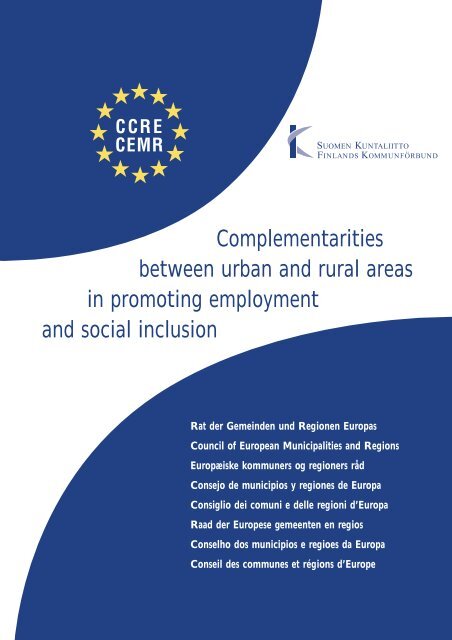
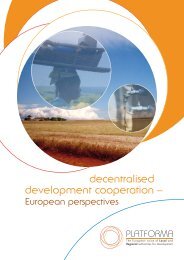

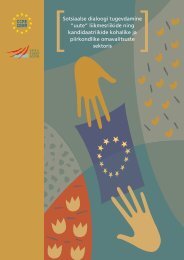






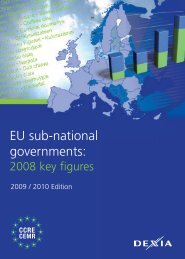
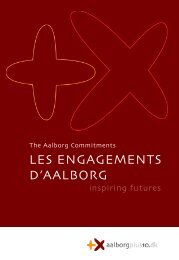
![[ ] Les jumelages pour le monde de demain](https://img.yumpu.com/29721946/1/190x96/-les-jumelages-pour-le-monde-de-demain.jpg?quality=85)

